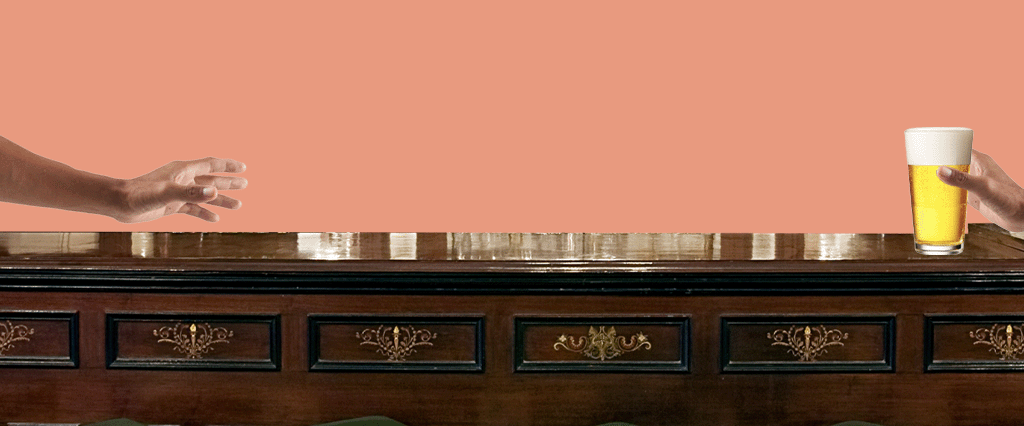Brittany Mendez remembers many of the slow nights she spent killing time with other bartenders on the Florida coast. But there was one night she remembers a little too well. “We used to make up games, stacking plastic shot glasses and coasters, that kind of thing,” she tells me. “One night, the game was to see who could slide a mug of beer to the end of the bar the fastest without it falling off.”
On the count of three, Mendez and another bartender sent two frosty mugs down the bar like pucks on a shuffleboard. “As soon as it left my hand, I realized there was a huge stack of shot glasses and coasters on the other side of the bar,” she recalls. “But it was too late, the beer collided with the shot glasses and erupted off the end of the bar, spraying glass, beer and coasters all over the floor and bar.”
Needless to say, Mendez quickly discovered that “sliding a drink down the bar isn’t as easy as it looks in the movies.” And in her seven years of bartending, she learned that the flashy move requires a lot more calculation than you might think. “You can perfect the push all you want, but the variables lie in the bar itself,” she explains. “Some bartops have grooves in them, while others might have cracks. The bar could be randomly sticky in some spots even though you just cleaned it. Other spots might be incredibly smooth.”
When surveying a bar to attempt a beer-slide, she adds, “You want it to be slick, but not too slick, because you’ll send it right off the edge like I’ve done many times before.”
“It does take practice — maybe three or four times — but you’ll get it,” says Jonathan Solis, bartender at the Torrance Marriott Redondo Beach and a top three finalist in the annual Masters of the Craft culinary and beverage talent competition. “Ultimately I’d recommend using something like a rocks glass, which is heavier, with a lower center of gravity — perhaps put an Old Fashioned in it, so the big ice cube gives it a little more weight.”
And if the bottom of the glass is wet, “that’ll make it easier to slide down the bar, too, making it a smoother interaction,” he continues. “The bar needs to be smooth, so instead of a rustic wood bartop with holes and crevices, a granite or glass surface would make it seamless.”
According to Jim Mumford, a mechanical engineer in Michigan, the “physics speak” aligns with the bartenders’ sentiment. “This is a version of the classic engineering problem called slipping or tipping,” he tells me. “Essentially, if you fling the glass too hard, or if the friction between the glass and bar is too high, the glass will tip instead of sliding, pissing off the guests and the barback.”
The delicate balance between the force of the push and the friction beneath the glass makes the maneuver all the more tricky, “as anyone who has played shuffleboard can attest, the margin of error is razor thin,” he says.
To achieve the coveted “perfect slide,” Mumford suggests coating the bar in water to solve the randomly sticky spots that plagued Mendez’ attempts. “An unexpected change in that friction will likely cause the glass to tip over, or at the very least spill,” he says. “But an evenly wet bar will allow for less oomph to slide the pint, which is critical.”
And when dealing with a taller pint glass instead of the aforementioned shorter rocks glass, Mumford says your best bet is to push the glass at the lowest one to two inches of the pint. “Pushing too high on the glass will cause the pint to want to rotate top down instead of slide, so pushing at the bottom helps prevent tipping at the very start of movement, when it’s most critical,” he explains.
Put it all together, and pushing a pint of beer down a wet bar “will take a very gentle throw with a slight twist for an ideal slide of about eight to ten feet,” Mumford concludes. “That’s moving the glass in your hand about six feet in a second before releasing.”
However, there is one more factor bartenders need to consider before dousing the bar in water and sending a couple pints flying. “It could turn out really awesome, or it could be a complete disaster,” Solis says. “Either outcome probably depends most on whether your bar guest appreciated it.”
But even that can go into a crafty bartender’s calculations. “It depends on the ambiance, the crowd and how well you know the person,” Solis says. “The person that ordered the drink might not appreciate a bartender throwing the glass at them at that speed without notice.”
As he points out, that can be an unpleasant surprise no matter how perfectly the drink arrives.

